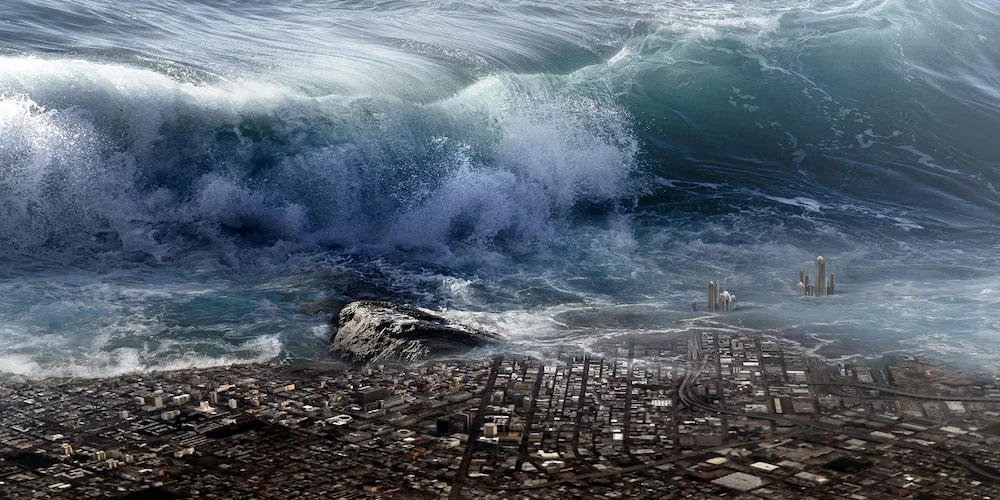Surviving the Tsunami: Stories of Resilience from the Indian Ocean Disaster
May 12, 2024
Natural Disaster History

On December 26, 2004, one of the deadliest natural disasters in recorded history struck the Indian Ocean region. A powerful undersea earthquake, measuring 9.1-9.3 on the Richter scale, triggered a massive tsunami that affected 14 countries, causing widespread devastation and loss of life. The Indian Ocean tsunami, also known as the Boxing Day Tsunami, left an indelible mark on millions of lives. Amidst the horror and destruction, stories of resilience, courage, and survival emerged, showcasing the strength of the human spirit in the face of unimaginable adversity. In this blog, we will explore the causes and impact of the tsunami, and highlight some of the remarkable stories of survival and resilience.
The Causes and Impact of the Tsunami
The Undersea Earthquake
The tsunami was triggered by a megathrust earthquake off the west coast of northern Sumatra, Indonesia. This earthquake was caused by the subduction of the Indian plate beneath the Burma plate, resulting in a sudden release of energy and a displacement of the sea floor. The enormous force of the earthquake generated a series of powerful waves that radiated outward across the Indian Ocean at speeds of up to 500 miles per hour.
Devastation Across Nations
The waves struck coastal regions with little warning, causing catastrophic damage and loss of life. Indonesia, Sri Lanka, India, Thailand, and the Maldives were among the hardest-hit countries. Entire communities were obliterated, infrastructure was destroyed, and millions of people were displaced. The death toll was staggering, with estimates ranging from 230,000 to 280,000 people losing their lives. The disaster also had long-term economic, social, and environmental impacts that are still felt today.
Stories of Resilience and Survival
The Miracle of Aceh, Indonesia
Aceh, a province in Indonesia, was the closest landmass to the epicenter of the earthquake and experienced some of the worst devastation. In the midst of the chaos, remarkable stories of survival emerged. One such story is that of a young boy named Martunis, who was just seven years old when the tsunami struck. Martunis was swept away by the waves and survived for 21 days by clinging to a mattress and scavenging for food and water. His remarkable endurance and survival captured the world's attention and brought hope to many.
The Survival of Tilly Smith, Thailand
In Thailand, a 10-year-old British girl named Tilly Smith became a hero after saving dozens of lives. While on vacation with her family at a beach resort in Phuket, Tilly recognized the signs of an impending tsunami—receding water and frothy waves—from a geography lesson she had recently learned. She urgently warned her family and others on the beach, prompting them to evacuate to higher ground. Tilly's quick thinking and knowledge undoubtedly saved many lives that day.
The Determination of Kamaljeet Singh, India
Kamaljeet Singh, a fisherman from Tamil Nadu, India, demonstrated extraordinary resilience and determination in the face of the disaster. When the tsunami hit, Kamaljeet was at sea with his crew. Despite the terrifying ordeal, he managed to steer his boat through the monstrous waves and safely returned to shore. Upon reaching land, he immediately joined the rescue efforts, helping to save numerous lives and providing aid to those in need.
The Courage of Phra Khru Ba Sai, Thailand
Phra Khru Ba Sai, a Buddhist monk from Thailand, showcased immense bravery and compassion during the aftermath of the tsunami. As the waves receded, he led efforts to rescue survivors and provide shelter and support to the affected communities. His temple became a refuge for hundreds of displaced people, and he worked tirelessly to offer solace and assistance to those in mourning. Phra Khru Ba Sai's selflessness and dedication exemplified the spirit of resilience and community support.
The Global Response and Lessons Learned
International Aid and Support
In the wake of the tsunami, an unprecedented global response ensued. Governments, non-governmental organizations (NGOs), and individuals from around the world mobilized to provide aid and support to the affected regions. Billions of dollars were pledged and delivered in the form of financial assistance, humanitarian aid, and reconstruction efforts. The outpouring of international solidarity highlighted the interconnectedness of humanity and the collective desire to help those in need.
Advances in Tsunami Warning Systems
The Indian Ocean tsunami underscored the critical need for effective early warning systems to prevent such catastrophic loss of life in the future. In response, significant advancements have been made in tsunami detection and warning systems. The establishment of the Indian Ocean Tsunami Warning and Mitigation System (IOTWMS) has enhanced the region's ability to detect and respond to tsunamis, providing valuable time for evacuation and preparation.
Building Resilient Communities
The disaster also emphasized the importance of building resilient communities that can withstand and recover from natural disasters. Efforts to improve infrastructure, enhance disaster preparedness, and promote sustainable development have been prioritized in many of the affected regions. Education and awareness programs have been implemented to ensure that communities are better equipped to respond to future emergencies.
Conclusion
The Indian Ocean tsunami of 2004 was a tragedy of immense proportions, leaving a lasting impact on millions of lives. However, amidst the devastation, stories of resilience, courage, and survival emerged, showcasing the strength and determination of the human spirit. The remarkable tales of individuals like Martunis, Tilly Smith, Kamaljeet Singh, and Phra Khru Ba Sai serve as powerful reminders of the capacity for hope and recovery even in the face of unimaginable adversity.
The global response to the disaster and the lessons learned have led to significant advancements in disaster preparedness and response. As we reflect on the events of that fateful day, we are reminded of the importance of solidarity, compassion, and resilience in the face of challenges. By honoring the memories of those who were lost and celebrating the stories of survival, we can continue to build a more resilient and connected world.